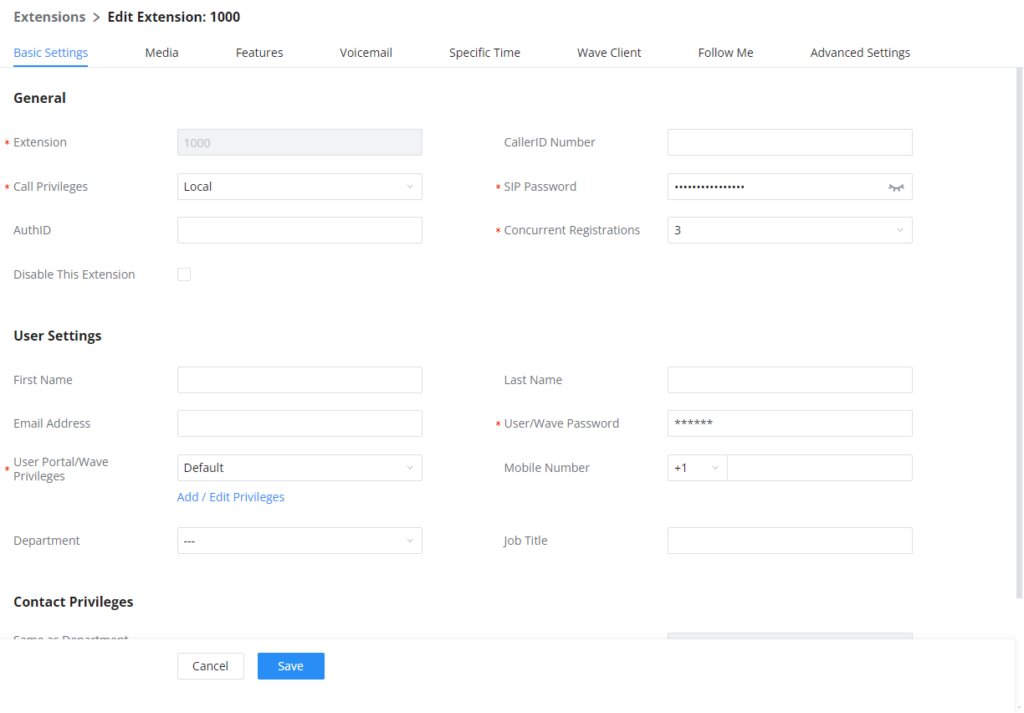Since the creation of the UCM series, Grandstream has always been advancing the technology and availability of the onsite IP PBX. We are incredibly excited to take the consistent innovation and development of our UCM series and bring it to the cloud with the introduction of CloudUCM. This solution can be accessed, setup, and managed on the Grandstream Device Management System, our cloud-based device management and monitoring platform. Check out our blog post here if you are not familiar with GDMS. While CloudUCM has all the same capabilities as our UCM series of IP PBXs, it comes with a substantial amount of additional benefits. We will cover all of this and more in this blog post.

Calling, Meetings, and Messaging – All in One Place
With CloudUCM, system integrators can create scalable and secure communication and collaboration platforms with powerful features and integrations that enable teams to be more productive than ever before. This Cloud PBX unifies all business communication into one centralized solution that provides voice and video calling, meetings, chat, data, analytics, mobility, surveillance, facility access, intercoms, and more. CloudUCM supports all SIP endpoints and the Wave app for desktop, mobile, and web, allowing teams to communicate and collaborate from anywhere on nearly any device.
Technical Specifications Overview
| Supported UC Endpoints and Client Devices | Support for all SIP endpoints
Wave app for desktop (Windows 10+, macOS 10+), web (Firefox, Chrome, Safari, Edge, Opera) and mobile (Android & iOS) Google Chrome extensions |
| Extensions and Concurrent Calls | Up to 200 extensions and 64 concurrent audio/video calls depending on the plan |
| Call Features | Call park, call forward, call transfer, call waiting, caller ID, call record, call history, ringtone, IVR, music on hold, call routes, DID, DOD, DND, DISA, ring group, ring simultaneously, time schedule, PIN groups, call queue, pickup group, paging/intercom, voicemail, call wakeup, SCA, BLF, voicemail to email, fax to email, speed dial, call back, dial by name, emergency call, call follow me, blacklist/whitelist, voice conference, video conference, eventlist, feature codes, busy camp-on/ call completion, voice control, post-meeting reports, virtual fax sending/receiving, email to fax |
| Organizational Collaboration Features | Audio and Video Meetings/Conferences, Instant Messaging and Group Chats with End-to-End Encryption, File Sharing, Screen Sharing, In-Meeting Chat, Voice Detection, Meeting Recording, Polls, Surveys, Message status, Advance Whiteboard with Multiplayer Annotation, Meeting Assistant, Onsite Meeting Room Scheduling, and more |
| Built-in Session Boarder Controller | Free All plans default to supporting built-in SBC services to protect CloudUCM systems from external attacks |
| Call with WebRTC Trunk | Supports mobile and desktop web browsers: Chrome, Edge , Safari, Firefox, Opera
Supports mobile applications with built-in WebRTC WebView, such as WhatsApp, Facebook, Weixin, and more |
| Customizable Auto Attendant | Up to 5 layers of IVR (Interactive Voice Response) in multiple languages |
| Customer Service Support | Supports integration with third-party customer service platforms, including WhatsApp, Telegram, and built-in live chat
Includes a built-in live online web chat platform to provide customer service Provides a web link that can be added to any web page or any browser that supports WebRTC Compatible with computers, mobile browsers, and mobile apps |
| Customer Relationship Management (CRM) | Supports integration with ACT!, Bitrix24, Freshdesk, Hubspot, Salesforce, Sugar, Vtiger, Zendesk, Zoho, Dynamics 365, and more |
| Call Center | Multiple configurable call queues, automatic call distribution (ACD) based on agent skills/availability/ work-load, in-queue announcement. |
| API and SDK | Full CGI API available for third-party platform and application integration
Wave add-in SDK Wave Andriod and iOS SDK Wave H5 Embedded for MAC/Windows applications |
| Security | Frequency Restriction, Fail2ban, Ping Defense, Ping of Death, SYN-Flood, Remote Login Interception, Multi-factor Authentication, SMS Login Authentication |
Features Overview
CloudUCM has a massive amount of voice, video, and collaboration features, allowing integrators to deeply customize the PBX solution for their customers to create exactly the solution they need. While we can’t provide an overview of every single one of those features within this blog post, we will highlight the major ones to provide a general idea of the platform’s capabilities. If you have already worked with our UCM series of IP PBXs, you will find a lot of commonalities between the two PBX solutions, with CloudUCM adding some extra features.
Extension and Trunks
Extensions can be deeply customized depending on the deployment, with up to 200 extensions depending on the plan. When creating a new SIP extension, all configurations and settings can easily be located throughout the user interface of CloudUCM with GDMS. The extensions are divided into several categories, their settings are briefly explained below.
- Basic Settings: The basic settings category of the extension is where to configure the core capabilities of the extension. Found here are options such as the extension’s user settings, password, contact privileges, and total registrations.
- Media: Here, you will find customizable configurations revolving around the performance of the extension. QoS capabilities such as jitter buffer, packet loss retransmission, and Video/Audio Forward Error Correction (FEC) can all be adjusted when needed to provide for a better call experience. SRTP and SIP codec/DTMF mode SIP settings are also adjustable here.
- Features: Under the features category, an extension’s operations can be adjusted depending on the needs and functions of the user. Internal and external settings such as Call Forwarding operations, Do Not Disturb conditions, Ring Simultaneously features, Call Center capabilities, Call Waiting, and much more are found here.
- Voicemail: Enabling and adjusting voicemail settings can be done in this tab. Keep in mind, complete voicemail settings can be found and configured under CloudUCM’s Call Features settings, under Voicemail.
- Specific Time and Wave: Time conditions can be configured through the Specific Time category, and enabling Grandstream’s Wave softphone application can be done via the Wave category.
- Follow Me: Lastly, Follow Me features are located under this tab, which enables calls to be seamlessly routed throughout a specified sequence.

Inbound and Outbound Routes
One of the most integral parts of a PBX is setting up the inbound and outbound routes that both internal and external calls take throughout the network. In CloudUCM, these routes can be deeply customized to fit any deployment a system integrator can come across. An outbound route pattern, country code, call duration limits, calling privilege level, trunks, failover trunks, and more are found under these settings. Simerly, an inbound route’s pattern, CID source, ringback tone, caller ID information, call privilege levels, DID destinations, and more can all be configured here as well.
For a complete list of inbound and outbound route features
Call Features Overview
CloudUCM comes with a massive array of call features that can be customized for any deployment. Offices, call centers, hotels, commercial chains, and more can all take advantage of the various settings and capabilities available. Below is a high-level overview of the most important features. If you would like to learn more about any of them, a link to their respective technical documentation can be found at the end of each bullet point.
-
- Interactive Voice Response (IVR): With up to 5 layers of IVR, system integrators can easily map out call routes based on organizational requirements. Rings groups, extensions, voicemail groups, paging/intercom groups, and more can all be included in an IVR, lending itself to be a helpful resource to help guide calls originating from outside of an organization or within it.
- Multimedia Meetings: CloudUCM supports multimedia meeting rooms allowing, multiple rooms used at the same time. Users can create, edit, view, invite, manage the participants, and delete multimedia meeting rooms. The multimedia meeting room status and meeting call recordings (if recording is enabled) will be displayed on this web page as well. For video meetings, which are based on WebRTC, participants can join the meeting from a PC without installing extra plug-ins or software.
- Voicemail: When enabled for a CloudUCM extension, global settings for voicemails can be set up under Call Features > Voicemail. This includes features such as voicemail access, behavior, email settings, voicemail groups, and more.
- Ring Groups: Ring groups are an important feature that provides various ring strategies for a unified communications network. They allow incoming calls to maneuver through set extensions based on a wide selection of configurations. This is ideal for sales groups, call centers, and other inbound call-heavy departments.
- Call Queue: Organizations that are consistently fielding incoming calls can take advantage of CloudUCM’s call queue functionality. The strategy for the queue can be set to ring assigned extensions simultaneously, in a specified order, based on who has been called the least, who has completed the fewest calls, randomly, or in a round robin schedule. Additional settings such as Music on Hold, Agent Rest Times, Welcome Prompts, Survey Prompts, Virtual Queues, and more can all be configured for a deeply customized queue.
- Paging/Intercom: Creating paging and intercom groups can quickly be done via the call features section of the CloudUCM GUI. Both 2-way and 1-way intercoms are supported, and extensions and extension groups can be selected for the intercom group.
- Other Features: CloudUCM supports a massive amount of additional features such as call parking lots, emergency calls, pickup groups, faxing, an announcement center, and more.
CloudUCM Integrations
On top of CloudUCM’s comprehensive collaboration voice, video, and messaging tools, integrators can also use its deep integration options for a wide variety of deployment scenarios. With the system’s built-in API, users can create an interface between CloudUCM and an application that sends HTTP requests to the platform. Call control capabilities enable the application to be able to manage inbound calls via the API as well. For a complete list of API queries that are supported by CloudUCM.
Next up, CRM and PMS integrations help deepen the capabilities of a CloudUCM deployment. By integrating a CloudUCM solution with a customer relationship management system such as Sugar CRM or Salesforce CRM, users can have the CRM’s data displayed upon an incoming call from a linked number. For example, upon answering an incoming call a sales agent can see the full contact information, lead status, and additional account details. These details can then be saved and updated to the relative CRM account after a call is completed and automatically logged. When it comes to Property Management System (PMS) integrations, CloudUCM supports features such as check-in/check-out, wake-up calls, room status, Do Not Disturb, and more. PMS integration can be done through Hmobile’s PMS solution, a PMS API, or locally managed through CloudUCM’s built-in PMS system.
Lastly, CloudUCM can integrate with Google Services, which allows for the PBX platform to automatically synchronize created Multimedia and on-site meeting schedules with the Google Calendars of the host and participants.
Complete PBX Customization
CloudUCM is the ideal PBX solution for small-to-medium-sized businesses, retail, hospitality, and residential deployments. Due to its highly customizable nature, system integrators can easily sculpt the capabilities of the platform to fit any organizational deployment. With management being done on the Grandstream Device Management System, an entire deployment of switches, routers, Wi-Fi access points, paging devices, IP endpoints, and now a cloud-based PBX can be done entirely from one single platform. CloudUCM is an all-in-one collaboration platform and a game-changer for unified communications installers across the world.


